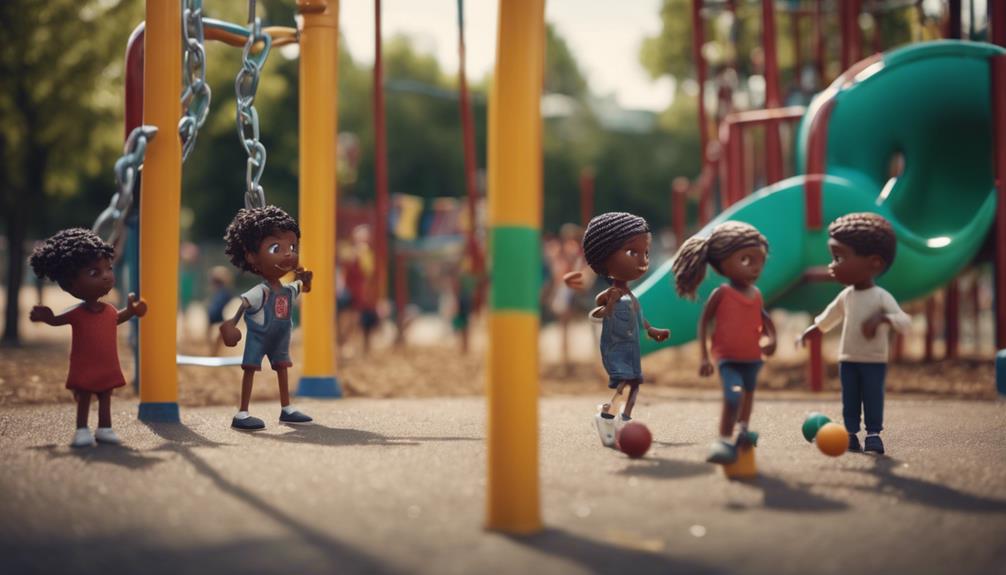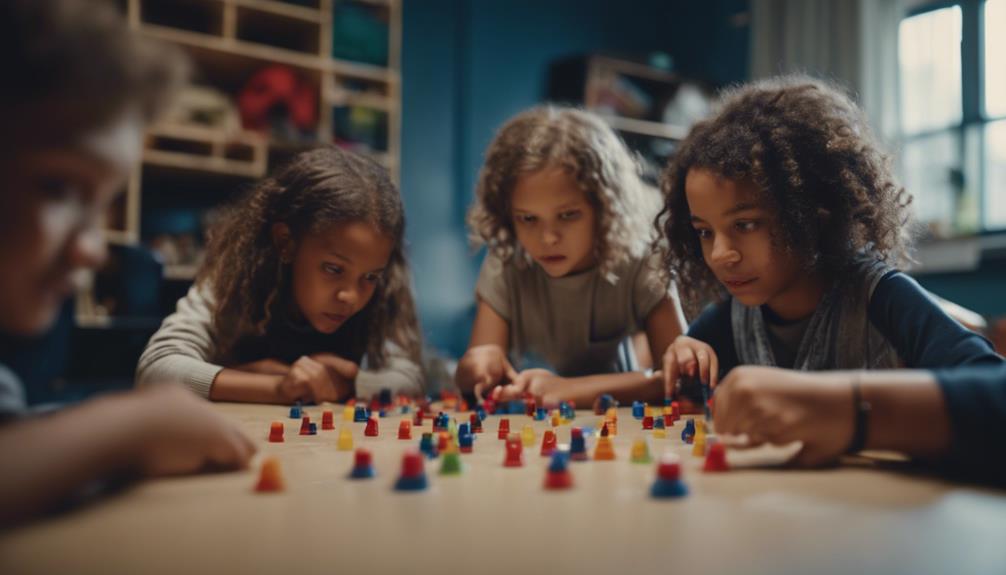Teaching children about ‘Stranger Danger’ and empowering them with essential skills through play is crucial for their safety. Recognizing warning signs, engaging in role-playing scenarios, and identifying trusted adults are all important components of this interactive learning process. Encouraging assertiveness, refusal of gifts from strangers, and promoting group play helps children develop resilience and confidence. Establishing boundaries, staying cautious, and seeking help from trusted individuals are vital aspects of safety education. Building confidence through role-playing and recognizing warning signs play a critical role in child safety. Invest in your child’s safety by incorporating play-based learning to equip them with life-saving skills.
Key Takeaways
- Use interactive role-playing to teach warning signs.
- Foster safety awareness through play-based education.
- Encourage identifying trusted adults for help.
- Teach refusing gifts from strangers and setting boundaries.
- Promote safety in numbers and playing in groups.
Understanding Stranger Danger
To protect yourself from potential risks, understanding stranger danger is essential. Teaching children about the warning signs of suspicious and potentially dangerous individuals is vital in promoting their safety. Children are often advised never to talk to strangers and to seek help from trusted adults if they feel uncomfortable or unsafe.
Educating children about stranger danger involves discussing scenarios where they might encounter unfamiliar individuals and how to react appropriately. By role-playing different situations and highlighting the importance of recognizing safe strangers, kids can better understand how to navigate encounters with unknown individuals.
Empowering children with the knowledge of stranger danger not only helps them stay safe but also instills a sense of awareness and preparedness in potentially risky situations.
Importance of Safety Education

Safety education is essential for children as it equips them with the knowledge and skills to navigate potential dangers effectively.
Through interactive learning activities, kids can engage in real-life scenarios to practice safety rules and responses.
Safety Awareness for Kids
Educating children about the importance of safety awareness plays a pivotal role in reducing their vulnerability to potential dangers. By teaching kids about staying safe, they can recognize warning signs and respond appropriately in risky situations.
Understanding safety empowers children to seek help from trusted adults when needed, promoting a sense of security and protection. Kids who are educated about safety develop confidence in setting boundaries and asserting themselves, especially when dealing with strangers.
This knowledge not only equips children with practical skills but also instills a sense of empowerment that can be vital in safeguarding their well-being. Safety education isn't just about imparting knowledge; it's about arming children with the tools they need to navigate the world securely and confidently.
Interactive Learning Activities
How can interactive learning activities enhance children's understanding of safety education?
Interactive learning activities play an essential role in teaching children about safety, particularly in the context of stranger danger. By engaging in role-playing exercises and hands-on scenarios, children can grasp safety concepts in a practical and memorable way. These activities empower children to develop essential skills to navigate potential dangers confidently.
Through interactive learning, children not only learn safety rules but also internalize them, fostering a deep understanding of how to respond to risky situations. Play-based safety education allows children to actively participate in creating safe environments, instilling a sense of responsibility for their own well-being.
Real-Life Scenarios Practice
Engaging in real-life scenarios practice is essential for children to develop effective responses to potential dangers. Through role-playing, kids can build confidence in handling dangerous situations and learn to recognize warning signs.
By actively participating in safety education exercises, children can understand how to stay safe in various scenarios. Practicing real-life scenarios not only enhances awareness but also empowers children to make informed decisions when faced with unfamiliar situations.
By simulating encounters with strangers and teaching children how to react, they become better equipped to protect themselves in the real world. This hands-on approach allows kids to internalize safety measures, making them more likely to respond appropriately when encountering potential risks.
Emphasizing real-life scenarios in safety education provides practical skills that can help children navigate different environments confidently and securely. By actively engaging in these exercises, children can develop the tools needed to stay safe and handle challenging situations effectively.
Role-Playing for Safety Awareness

Using interactive role-playing activities is a valuable method for enhancing safety awareness in children.
Role-playing allows children to practice responses to dangerous situations, such as being approached by strangers. By simulating real-life scenarios, children learn to react confidently, say no, seek help from trusted adults, and stay safe. This approach helps children understand the importance of being cautious and assertive in unfamiliar situations.
Additionally, role-playing teaches children to recognize warning signs of suspicious behavior and take appropriate actions to protect themselves. Through these simulated experiences, children develop the skills needed to navigate potential risks effectively.
By engaging in role-playing activities, children can internalize safety practices in a practical and engaging manner. This method not only educates children on safety protocols but also empowers them to respond proactively when faced with potentially harmful situations.
Identifying Trusted Adults

Identifying trusted adults is essential in equipping children with a reliable support system for seeking help in uncomfortable or dangerous situations. Talk to your children about the importance of having trusted adults they can turn to when dealing with strangers.
Trusted adults can be parents, grandparents, teachers, coaches, neighbors, or family friends. Encourage your children to identify at least three individuals whom they feel comfortable seeking help from. These trusted adults should be reliable, supportive, and known to the child in various settings to make sure they can provide assistance when needed.
Assertiveness Training for Children
Assertiveness training equips children with the skills to confidently respond to dangerous situations, empowering them to say no to strangers and seek help from trusted adults. Through role-playing exercises, children can practice setting boundaries and learn how to stay safe. This form of teaching safety emphasizes the importance of recognizing and avoiding potential risks from strangers.
By fostering assertiveness in children, parents and educators aim to instill the ability to listen to their instincts and take decisive action in unsafe situations. Encouraging children to assert themselves can help build their self-confidence and resilience when faced with unfamiliar or threatening encounters.
Refusing Gifts From Strangers

Teach children the importance of never accepting gifts from strangers to guarantee their safety. Strangers look out for opportunities to approach children with enticing offers, so it's vital to educate kids on the risks associated with accepting gifts from unknown individuals. Children need to understand that it's important to refuse gifts from strangers to keep themselves safe. Emphasize the signs of suspicious behavior that may accompany offers of gifts, such as strangers who never ask for permission from parents or exhibit overly friendly behavior. By instilling the idea that it's crucial to say no to gifts from unfamiliar individuals, children can learn to protect themselves from potential dangers. Below is a table summarizing key points regarding refusing gifts from strangers:
| Refusing Gifts From Strangers | Importance |
|---|---|
| Teach children to say no to gifts from strangers | Vital for safety |
| Emphasize signs of suspicious behavior | Protects from potential risks |
| Encourage setting boundaries and declining offers | Prioritize safety |
| Reiterate the message that it's okay to refuse gifts | Ensure safety and well-being |
Safety in Numbers

When children play outside or in public places, their safety is enhanced by sticking together with friends or siblings to create safety in numbers. Playing in groups not only fosters a sense of camaraderie but also acts as a deterrent to potential predators.
Encouraging kids to stay with a buddy can provide added support in emergencies and unfamiliar situations. In the scenario of a stranger approaching in a car, being in a group can help children feel more confident and secure.
It's crucial to teach children about the concept of safe strangers and the importance of playing in groups, especially in public places. By emphasizing the value of staying together, parents and guardians can instill a sense of responsibility and awareness in children when it comes to their own safety.
Avoiding Unknown Interactions
To protect yourself from potential risks, being cautious around unfamiliar individuals is essential. Children should know that in dangerous situations, it's okay to say no to adults who make them feel uncomfortable. One way to prepare children for these scenarios is by teaching them about safe strangers like Police officers. Below is a table that highlights key points on how children can navigate unknown interactions effectively:
| Situation | Action |
|---|---|
| A stranger offers you candy | Politely decline and walk away |
| An adult asks you to keep a secret | Remember not to keep secrets from parents or trusted adults |
| You feel unsafe and need help | Look for a police officer or a teacher for assistance |
| A stranger in a car asks for directions | Keep a safe distance and do not approach the vehicle |
| An adult asks you to go somewhere with them | Politely refuse and find a trusted adult for help |
Building Confidence in Children

Exploring unfamiliar interactions adeptly can instill confidence in young children to handle potential risks with assertiveness. Role-playing scenarios, such as those provided by KidSmartz, offer a safe environment for children to practice responding to danger, thereby boosting their self-assurance.
Teaching children to stay put if they ever find themselves lost not only guarantees their safety but also empowers them to navigate dangerous situations with confidence. Encouraging children to make noise when in distress can give them the courage to take action and attract attention for rescue effectively.
By educating children on warning signs of suspicious behavior, they can develop the confidence to recognize and respond to potential dangers proactively.
Incorporating these strategies into safety training for children not only equips them with essential skills but also fosters a sense of confidence in their ability to handle challenging situations. Building confidence through preparedness and practice is key in helping children navigate the complexities of personal safety with resilience and assertiveness.
Frequently Asked Questions
How Do You Teach a Child Stranger Safety?
When teaching a child stranger safety, emphasize the importance of recognizing safe adults, saying no assertively, and seeking help. Encourage them to not talk to strangers, refuse gifts, and stay with friends for safety.
How to Help Babies With Stranger Danger?
Help babies with stranger danger by teaching them to recognize familiar faces and voices for security, like a lighthouse guiding ships to safety. Gradually introduce new people in a controlled setting, model appropriate reactions, and provide a safe environment for learning.
What Are Four Rules of Stranger Danger Safety?
Never talk to strangers, don't accept gifts, yell no, and avoid cars. Remember these rules to stay safe. Practice through play helps you learn and stay smart. Role-play and group safety can make a difference.
Why Is It Important to Teach Stranger Danger?
Just like a compass guides you through unknown paths, teaching stranger danger is essential for your safety. Understanding how to respond in risky situations and recognizing safe options empowers you to seek help confidently.
Conclusion
To sum up, teaching children about stranger danger through play is an essential aspect of safety education. By incorporating role-playing scenarios, identifying trusted adults, and emphasizing assertiveness and refusal skills, parents and caregivers can help build confidence in children to navigate potentially dangerous situations.
Remember, safety is a priority and ensuring children are equipped with the knowledge and skills to protect themselves is vital in today's world. Stay vigilant and proactive in teaching safety practices to keep children safe.








